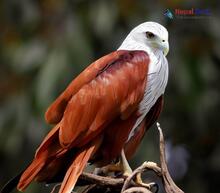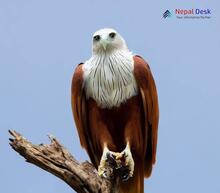Nepal, a diverse country nestled between China and India, is home to magnificent landscapes, towering mountains, and an abundance of flora and fauna. One of the unique aspects of Nepal's rich biodiversity is its birdlife – hosting over 900 bird species. Among these fascinating avian creatures is the remarkable bird genus Haliastur, known for its distinct characteristics and captivating presence. Here, we'll take a closer look at the Haliastur birds found in Nepal and why they're worth your attention.
Getting to Know the Haliastur Genus
The Haliastur genus belongs to the Accipitridae family, which includes hawks, eagles, and kites. This genus comprises two species commonly found in Nepal: the Brahminy Kite (Haliastur indus) and the Whistling Kite (Haliastur sphenurus). Both are medium-sized birds of prey with impressive wingspans and striking appearances.
The Brahminy Kite: A Cultural Symbol
The Brahminy Kite, also known as the "red-backed sea-eagle," is a prominent bird in Nepalese culture. Revered for its spiritual significance in Hinduism and often associated with Lord Vishnu’s vehicle, this bird is characterized by its reddish-brown plumage, contrasting white head and breast, and sharp hooked beak. They are predominantly found near water bodies such as rivers, lakes, and coastal regions where they feed on fish, insects, small mammals, and carrion.
The Whistling Kite: An Elegant Hunter
Distinguished by its rusty-brown plumage adorned with bold streaks on the underparts and a powerful curved beak, the Whistling Kite gets its name from its unique vocalization – a loud descending whistle. Found in a variety of habitats including forests, grasslands, and wetlands, these raptors have a versatile diet, consuming everything from insects and fish to small mammals and birds. As opportunistic hunters, they may also scavenge on carrion alongside their more frequent aerial hunting strategies.
Conservation Efforts for Haliastur Birds
Both Haliastur species play a crucial role in maintaining the ecological balance of the regions they inhabit in Nepal. However, like many other bird species worldwide, habitat loss, pollution, and climate change pose significant threats to their population. To preserve this extraordinary bird genus, various conservation organizations such as Bird Conservation Nepal (BCN) and the Nepalese Department of National Parks and Wildlife Conservation are undertaking measures to protect critical habitats and raise awareness about the importance of these birds for maintaining biodiversity.
In Conclusion
Nepal's remarkable landscapes and cultural diversity extend to its unique birdlife as well. The Haliastur genus, with its two captivating species – the Brahminy Kite and the Whistling Kite – is an excellent example of the country's rich avian diversity. Next time you venture out into Nepal's natural splendors or watch over the magnificent rivers flowing through this captivating land, keep an eye out for these fascinating birds of prey – true symbols of nature's awe-inspiring wonder.




